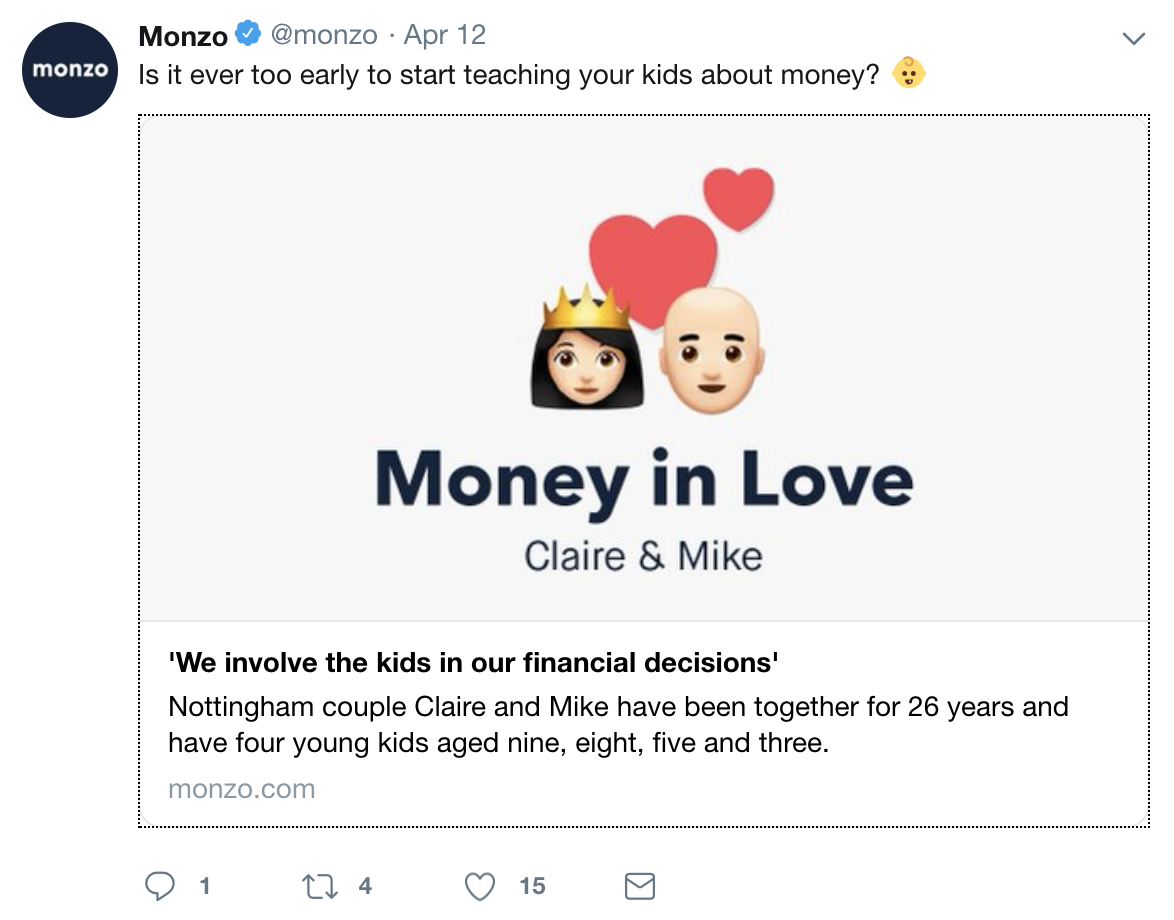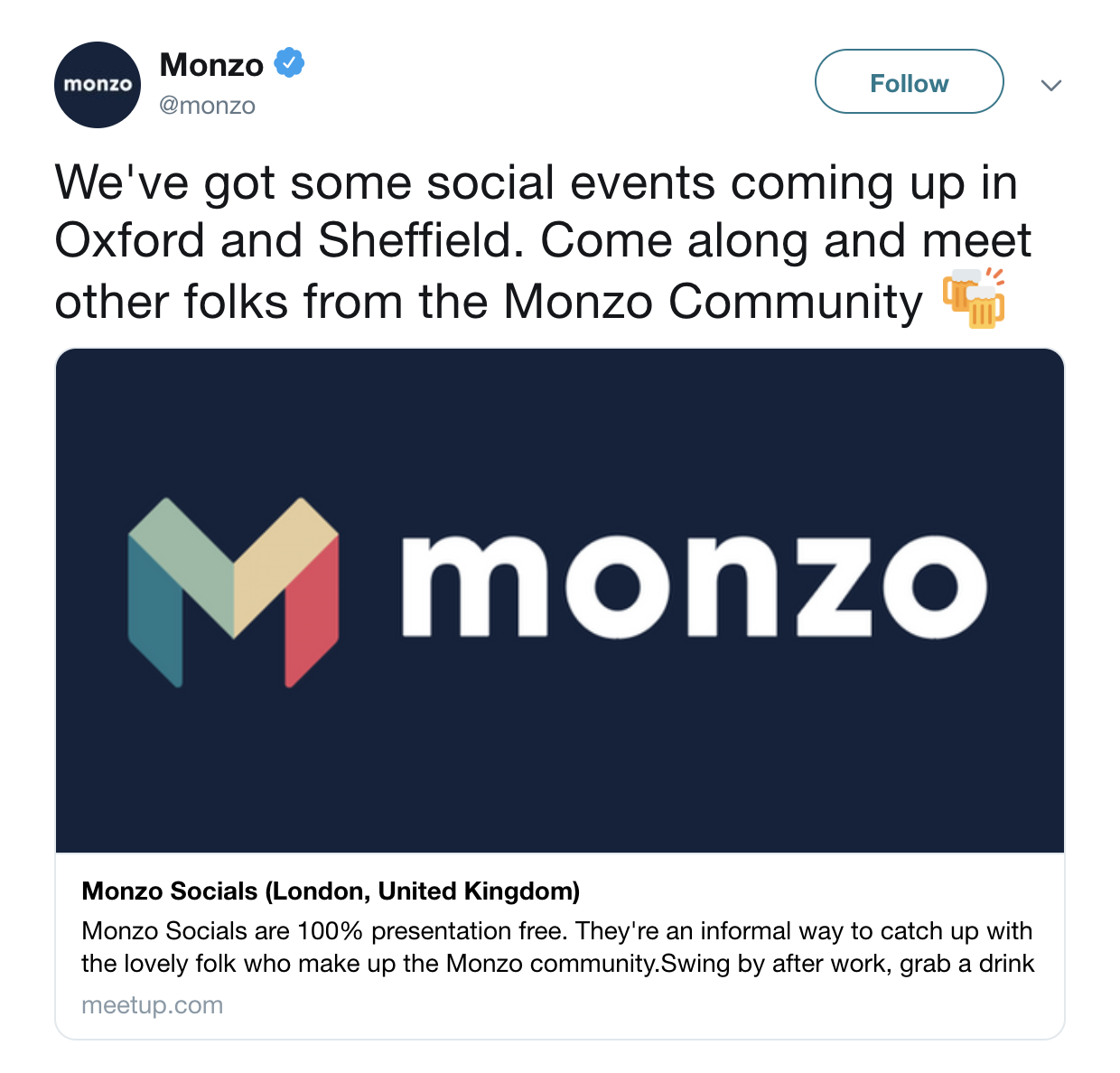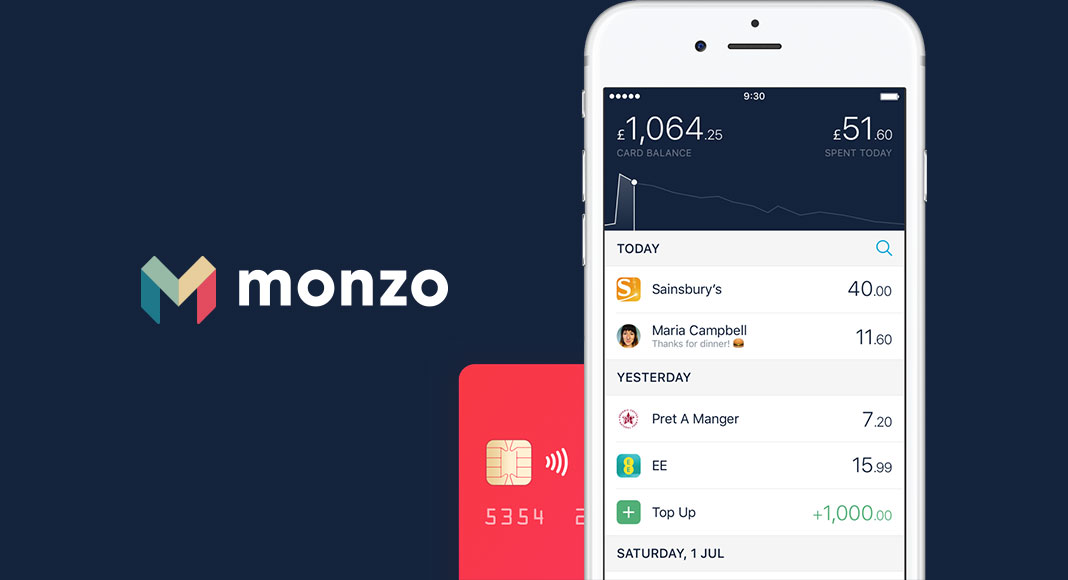Right, I’m just going to say it. Monzo are nailing it right now!
They are an exemplar both in their sector and, to some extent, in the business community. If you’ve read my article on emojis in business, you’ll notice that I featured Monzo quite heavily. The reason for this is that they are great at speaking to customers and wider stakeholders.
Their approach to commercial banking is disrupting the market and so, in my opinion, here are some of the great things that Monzo are doing that makes them stand out to me!

Tone of Voice isn’t just what Monzo or any business says, but it’s how they go about it. Monzo have got a really nice tone across their website, in-app chat, emails, social media and ultimately throughout it’s product; it’s banking app.
Monzo has managed to stand out from the sector with its distinctive voice and product offering and seems like a unique player in this very cluttered, often quite traditional market place.
Most importantly, how Monzo communicates with its customers ultimately builds trust and brand loyalty which are key to long term growth. This is a bit of long article, but having read their Tone of Voice guide as well as a lot of their content, its worth reading through as it will help you make a real difference to your brand’s voice strategy.
Tone of Voice Guide
Right, so this is amazing! The business is so transparent, they have shared their tone of voice guide. This is not some long PDF brand guidelines, this is a clear and honest look at how they talk to their customers. This is worth a read for anyone who is looking after brand, tone of voice or customer engagement as it’s really taking it to the next level. They’ve even shared their employee social media guidelines, however transparent is that!
Hello! 👋
Welcome to Monzo’s tone of voice guide.
This is a (fairly) brief overview of how we write. It’s for everyone in every team, and it applies to all the writing we do, inside and out.
We’ve opened this up to the world as well (hello world! 🌍), because we want to be held up to the lofty standards we set ourselves here. We believe in everything we’ve said, so if you see us falling short then please let us know.
Introduction to the Tone of Voice Guide – © Monzo
Even how they they introduce the guide is conversational, honest and feels like it was written by a human being, in this case its Harry Ashbridge who is even named on the guide with his personal email address! This is fantastic because it humanises a bank, which is an incredibly different skill as customers can often feel like a number, whereas Monzo clearly use the word “people” throughout.

The following sections of this article will look in a bit more detail at each of Monzo’s Tone of Voice sections and explain how you can make changes to your business so you can try and implement some of the great work that Monzo has. Even their use of imagery in their tone of voice guide is great and really separates them from the text heavy websites of traditional banks.
For anyone who works with employer brand, they share some great content on LinkedIn including stories from employees and just general employee updates. This is great for attracting employees and could be implemented fairly easily if there some focus on content.

LinkedIn – Monzo Bank

Use of language
Firstly, one of the greatest things that Monzo do is avoiding corporate and business languages when speaking with their customers as this is how people actually speak. This is fantastic because it once again humanises the brand so customers don’t feel like their talking to this untouchable corporate beast.
“The best test for this is to read what you’ve written out loud.”
Monzo
They’re honest as well, and admit that sometimes they just cannot avoid technical knowledge given that they are still a bank and that some of the words they use might sometimes be unclear to those new to banking terminology. However, they are excellent at explaining things for those who have less knowledge if they need it.

Twitter – @Monzo
They’re also not afraid that how they speak will affect their authority as a bank. It’s even backed up by research which shows how people prefer plain english rather than formalised English.
By speaking in the way that your customers speak, breaks down the corporate barrier and allows your audience to feel like they are getting to know your brand and ultimately build up a level of trust, which often cannot be achieved if you act as a corporate giant.
“Being serious isn’t the same as being formal. That’s the crucial difference between content (what we say) and tone (how we say it).”
Monzo
Have you looked at your tone across you channels? Why do you speak like you do as a business? Is this led by your senior management and how they think the business should speak? Have you spoken to your customers recently and listened to how they use language?

Ambitious and positivity
One of my favourite lines from the Tone of Voice guide is this; “always focused on what matters to people” which is completely refreshing to hear.
Having this at the core of your communications both internally and externally, will remind everyone within your organisation who is the most important stakeholder group to the business. Cleverly, people can refer to customers, staff or even investors but what it does it remind everyone that even behind every big organisation, there are people at it’s heart.
The guide places real focus on what it is important to the reader, in this case both online content, in-app content and ultimately human to human conversations.
“Are they more interested in the process we took to decide something, or how that decision affects them? (Hint: it’s almost always the latter.) “
Monzo
Firstly, this statement is great because it really hits home that you should just get to the point. But they don’t forget that people want to know why it happened but they just order what they tell people so they get the key information first.
Another thing, I love the use of brackets in the statement. It’s a little cheeky element to the guide which is something a human would do – showing even their corporate guidance to tone of voice follows their tone of voice guidance.
“Everything we do is for them, and they deserve a share of the credit whenever we celebrate our successes.”
Monzo
They’re also great at showcasing customer success stories. This one is all about Claire and Mike from Nottingham which looks at their family finances and then shares their blog on the Monzo corporate website giving back to their customers in some free publicity. Or Katherine & Christina from Manchester which looks at the difference of new couples and how Monzo can help with their finances.

Twitter – @Monzo
Finally, a sub section they call ‘magic dust’, explains how they use punctuation or emojis to add positivity to messaging, whilst maintaining control so it doesn’t feel forced or unnatural. Their guidance really shows that they’ve thought about over usage and how it can actually do more damage than good.
This is something to consider when developing your own guide. Make sure you are developing a guide with clear use guidelines.
People within the organisation can get overexcited with the use of emojis or superlative words which can actually lose the effect of the positive change you intended to make. I think using positive messaging is great when communicating with audiences and really looking at what is important to our customers is key to delivering them messages in a timely and digestible manner.
(If everything’s awesome, then is anything really awesome? 🤔)
Monzo

Transparency
Right, so this section in their guide is essentially all about clarity and signposting and how you can use this to become more transparent in what you do.
Side note, if you work on the communications for Equality and Diversity team within your business, then their recent update is a fantastic read and incredibly open.
The first thing they focus on is being clear about who is making decisions that affect their customers. Businesses shouldn’t hide the corporate veil and the active voice should be used rather than a passive voice. Using the active voice allows them to take ownership of decisions and makes the communications, again, more personal.
They include some great examples of passive vs active and it is really clear how this would affect how a customer reacts to a decision made. Their monkey 🐵test is also a great little read. I won’t share it in here because you should really check out their whole guide but it’s definitely worth a read.
Next up is subheadings and bullet points. They know that their customers and people in general are skim readers therefore subheading and bullet points can help their audience understand the point quicker and understand what is trying to be communicated.
Basically, they want everything to be made clear to the reader so that they can get on with their life. They don’t leave out the detail though. The detail is always available but usually under a header so it can be read if needed.
“The trick with subheadings is to summarise the essence of what you’re trying to say in one line.”
Monzo
There’s a few great tips for any communications professional from this section of the guide. Notably the Monkey test 🐒, which will allow you to make some great steps in the short term. Basically, understanding that your customers might not have a free two hours to read an email and might just want it summarising in 5 clear sections is a great first step.

Openness and inclusivity
Their final section is all about openness and inclusivity. The ‘Monzo Community’ as they refer to it, is an inclusive place which means that alongside clearly stating their objection to any racist, sexist or derogatory comments, they go even further to make Monzo an inclusive place.
Their first area is removing the gender pronouns from how they speak. By not using the term ‘guys’ which isn’t very inclusive for groups with women in it, they have stated they’ll use terms like ‘folks’, ‘everyone’ or ‘hey y’all’.
This is a great step for bank or any business because for their customers it shows that they care about the things that their customers care about including inclusivity, equality and the use of labels in society.

Twitter – @Monzo
Their final section is all about emojis! I spoke about their use of emojis in my article on emojis in business. Again, like their use of superlative language, they tell their employees to keep in mind that over-usage can actually do damage and reduce their effect.
Their usage of emojis is all about adding context and allow personality to shine through, they are not to reduce word count or reduce the use of words in their communications because this might confuse some of their audiences who do not use them. They even take into consideration about the use of screen readers for their blind or visually impaired customers reminding staff not to make content different to read.
“If their writing is emoji-tastic, then feel free to be the same. But if they’re not using any, or if you’re talking about a particularly sensitive subject or giving bad news, it might not be the best place for emojis.”
Monzo
Their understanding of their customer is totally fantastic and really place importance on being flexible depending on the needs and personality of the customer they are speaking to.

This whole guide is a fantastic example of how a big business is taking charge of their tone of voice and there is something that every communications professional can take on board and implement into their own business.
I cannot rate this highly enough and will always keep this Tone of Voice guide as a piece of best practice when making decisions in my work.
If you have any comments or areas that you think I have missed, please do let me know.
Follow me on Twitter for more updates . . . @BradTheCommsGuy
All images and graphics throughout this article are taken from the Monzo website and are owned by Monzo.


Leave a comment